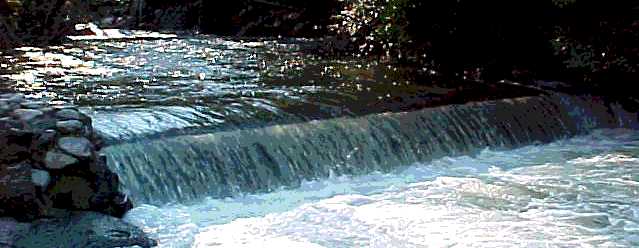Chemical energy is a form of potential energy and it is possessed by things such as food, fuels and batteries. As stated by the first law of thermodynamics, energy can neither be created nor destroyed; it can only be converted from one form to another. During chemical reactions, molecules can be created or destroyed. If a product is created, the chemical energy is stored in the bonds that make up the molecules. If something is broken down, the chemical energy is released, usually as heat. If a reaction releases energy, it is called exothermic, and if it absorbs energy, it is called endothermic.
One example of chemical energy is that found in the food that we eat. Energy is stored in the bonds of the molecules that make up food. When we eat the food, the large molecules are broken down into smaller molecules that can be used by the cells of the body. The process of breaking down and using the food by our cells is called respiration. During respiration, the chemical energy is converted to heat, kinetic energy, and other forms of chemical energy, like that stored in the fat cells in our body.

Gravitational potential energy
Gravitational potential energy is energy stored within an object due to its height above the surface of the Earth. In order for an object to be lifted vertically upwards, work must be done against the downward pull of gravity. The amount of energy used to lift the object against gravity is then stored as gravitational potential energy within the object. When the object is released and falls towards the Earth, the stored energy is converted into kinetic energy, the energy of movement.

The water above receives energy as it falls down the short waterfall. This energy was stored as potential energy in the gravitational field of the Earth and came out of storage as the water dropped. This energy which came out of the gravitational field ended up being expressed as the kinetic energy of the water. That is, the water gains kinetic energy as it drops. An ounce of water is going faster when it hits the bottom of the waterfall than it was when it went over the top of the waterfall.
Elastic potential energy
Elastic potential energy is the energy that is stored by the forces within a distorted elastic object. One of the easiest ways to understand the concept is to study to mechanics of an ordinary spring. It is also best to break down the various components of elastic potential energy in order to gain the most in depth knowledge.
When studying elastic potential energy, many people also consider the elastic limit of an object. For example, if you pull on a spring, it is possible to pull it too far. When pulled too far, the spring can become distorted and it will exert less force. In most cases, once the spring or any other object has exceeded its elastic limit, it will become deformed — usually permanently so.
Distorting an object, such as a spring, takes work. It can be stretched by hand, simply by pulling the ends out. When the ends are pulled outward, energy from the person pulling is transferred to the spring. The spring stores the energy and it is called elastic potential energy.

Mechanical potential energy
Mechanical energy is the sum of energy in a mechanical system. This energy includes both kinetic energy, the energy of motion, and potential energy, the stored energy of position. Mechanical energy exists as both kinetic and potential energy in a system. Kinetic energy, the energy of motion, exists whenever an object is in motion. Potential energy is based on the position of an object. It can not cause any change on its own, but it can be converted to other forms of energy. For example, A bowling ball placed high above the ground would possess no kinetic energy. It would, however, possess a large amount of potential energy that would be converted to kinetic energy if the ball were allowed to fall.

Thermal energy
Thermal energy is generated and measured by heat of any kind. It is caused by the increased activity or velocity of molecules in a substance, which in turn causes temperature to rise accordingly. The laws of thermodynamics explain that energy in the form of heat can be exchanged from one physical object to another. For instance, putting fire under a pot of water will cause the water to heat up as a result of the increased molecular movement. In that way, the heat, or thermal energy, of the fire, is partially transmitted to the water. Thermal energy is an awesome force that is just beginning to be fully understood. By creating new devices and methods to concentrate, store, and transport naturally-created thermal energy, human beings can reduce dependence on non-sustainable forms of energy. Thanks to the power of heat, hot baths, boiled water, and thermally-powered cities are all possible.

Sound energy
Sound energy is the energy produced by sound vibrations as they travel through a specific medium. (Sound travels at different speeds depending on the material it is travelling through; It travels the fastest through solids because they are so dense. It travels slower through liquids and gases because they're not as dense.) Sound vibrations cause waves of pressure which lead to some level of compression and rarefaction in the mediums through which the sound waves travel. Sound energy is, therefore, a form of mechanical energy; it is not contained in discrete particles and is not related to any chemical change, but is purely related to the pressure its vibrations cause. Sound energy is typically not used for electrical power or for other human energy needs because the amount of energy that can be gained from sound is quite small.
Rather than measuring sound in typical units of energy, such as joules, scientists and others tend to measure it in terms of pressure and intensity using units such as pascals and decibels. Sound measurements are, by their very nature, relative to other sounds that cause more or less pressure. Usually, sound is described in terms of the way it is perceived by healthy human ears. A sound that produces 100 pascals of pressure at an intensity level of about 135 decibels is, for example, commonly described as the threshold of pain. It is of adequate pressure and intensity, often combined into the common term "loudness," to cause physical pain.

